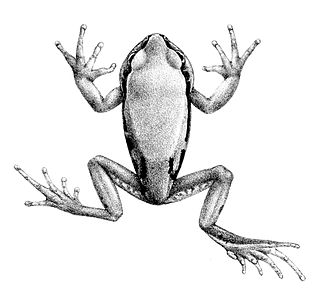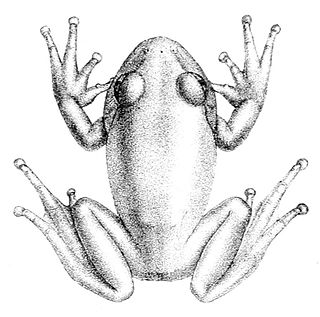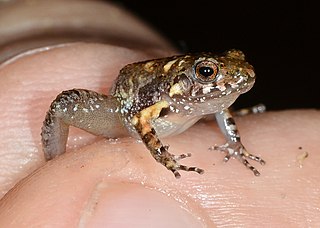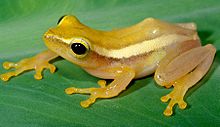
Polypedates is a genus of frogs in the family Rhacophoridae, the shrub frogs and Paleotropic tree frogs. They belong to subfamily Rhacophorinae. Members of this genus are collectively known as whipping frogs. They occur in eastern and southern Asia.

Hyla annectans is a species of tree frog in the family Hylidae. It is found in Asia south of the Himalayas in northeast India, northern Myanmar, and northern montane Vietnam and southwestern and central China. There are isolated records in northwestern Thailand and adjacent Myanmar. There is uncertainty whether Hyla gongshanensis from China should be recognized as a distinct species. This widespread species has many common names: Jerdon's tree frog, Assam treefrog, Indian hylid frog, green leave frog, or Southwestern China treefrog.

Aplastodiscus albosignatus, also known as the Bocaina treefrog, is a species of frog in the family Hylidae. It is endemic to Brazil. Its natural habitats are subtropical or tropical moist lowland forests, subtropical or tropical moist montane forests, and rivers. It is threatened by habitat loss.

Callimedusa tomopterna, the tiger-striped tree frog, is a species of frog in the family Phyllomedusidae. It is found in northern South America in the Upper Amazon Basin of Bolivia, Peru, Ecuador, and Colombia, Amazonian Brazil, and the Guianas from southeastern Venezuela to French Guiana. It might represent more than one species.
Leptopelis christyi, also known as the Christy's tree frog or Christy's forest treefrog, is a species of frog in the family Arthroleptidae. It is known with confidence from eastern and northeastern Democratic Republic of Congo, southern and western Uganda, and northwestern Tanzania. It is likely to occur in Burundi and Rwanda, possibly ranging further in East Africa. There is an isolated population in Cameroon and Gabon that might represent a distinct species. The specific name christyi honours Dr. Cuthbert Christy, a British army doctor who collected the holotype.

Leptopelis gramineus is a species of frog in the family Arthroleptidae. It is endemic to Ethiopia and occurs on the Ethiopian Highlands on both sides of the Great Rift Valley. Common names Badditu forest treefrog and Ethiopian burrowing tree frog have been coined for it.

Leptopelis viridis is a species of frog in the family Arthroleptidae. It is widely distributed in the West and Central African savanna zone between Senegal and the Gambia to the northeastern Democratic Republic of Congo.

Craugastor pygmaeus, also known as the pigmy free-fingered frog or the pigmy robber frog, is a species of frog in the family Craugastoridae. It is found in western Guatemala and southern Mexico from southern Sinaloa to Chiapas.
Metaphrynella pollicaris is a species of frog in the family Microhylidae. It is endemic to Peninsular Malaysia.

Nyctibatrachus beddomii is a species of frog in the family Nyctibatrachidae. The epithet or specific name, beddomii, honors Colonel Richard Henry Beddome (1830-1911), British naturalist and military officer.
Cornufer hedigeri, commonly known as the Treasury wrinkled ground frog or Solomon Islands giant treefrog, is a species of frog in the family Ceratobatrachidae, named after Henry B. Guppy who collected the holotype from the Treasury Islands. It is widespread in the Solomon Islands archipelago, though it is missing from New Georgia and Makira islands.

Chirixalus doriae, commonly known as Doria's Asian treefrog, Doria's bush frog, Doria's bush frog, and Doria's tree frog, is a species of frog in the family Rhacophoridae. It is found in southeastern Asia, from extreme northeastern India and adjacent Bangladesh to Myanmar, Thailand, Cambodia, Laos, Vietnam, and southern China.
Feihyla hansenae, also known as Hansen's Asian treefrog, Hansen's bushfrog, and Chon Buri pigmy tree frog, is a species of frog in the family Rhacophoridae. As its range is currently known, it is endemic to Thailand, although it is likely that its true range extends into Myanmar, Cambodia, and Laos. The nominal species consists of two lineages that may represent distinct species. The specific name hansenae honours Dora Hansen, friend of Doris Mable Cochran who described this species.

Chirixalus nongkhorensis, also known as the Nongkhor Asian treefrog, Nongkhor pigmy tree frog, Nong Khor bushfrog, and Nongkhor foam-nest treefrog, is a species of frog in the family Rhacophoridae. It is found in north-eastern India (Assam), Myanmar, Thailand, Cambodia, Laos, Vietnam, and Peninsular Malaysia.
Feihyla palpebralis is a species of frog in the family Rhacophoridae, sometimes known as the Vietnamese bubble-nest frog or the white-cheeked small treefrog. In addition to its type locality, Langbian Plateau in southeastern Vietnam, it is found in southern China and northern Vietnam south to Tam Dao, and is expected to be found in the intervening Laos and Vietnam.

Polypedates leucomystax is a species in the shrub frog family Rhacophoridae. It is known under numerous common names, including common tree frog, four-lined tree frog, golden tree frog or striped tree frog. Many past authors have united it with the common Indian tree frog in P. maculatus, but today they are generally considered distinct species. In its native range, it is also called "white-lipped tree frog", but this name is otherwise applied to a species of true tree frogs.

Polypedates macrotis, commonly known as the dark-eared treefrog, sometimes also Bongao tree frog, Bongao bubble-nest frog, Baram whipping frog, or brown-striped tree frog, is a species of frog in the family Rhacophoridae. It is found in the central peninsular Thailand, Sumatra, Borneo, and Sulu Archipelago as well as a range of other Philippine islands.

Rhacophorus lateralis is an endangered rhacophorid tree frog endemic to the Western Ghats in South India. It has several common names: small tree frog, Boulenger's tree frog, small gliding frog, and winged gliding frog. After its original description in 1883 by George Albert Boulenger, the frog was rediscovered in Coorg in 2000 and has since been found in many parts of the Western Ghats around southern Karnataka and northern Kerala. Along with R. malabaricus, it is one of the few anuran amphibians in India that constructs its nest above the ground using leaves.

Zhangixalus moltrechti is a species of frog in the family Rhacophoridae. It is endemic to Taiwan, where it has a wide distribution in hilly areas. Common names Moltrecht's green treefrog, Moltrecht's treefrog, Taiwan treefrog, and Nantou flying frog have been coined for it.

Feihyla is a genus of frogs in the family Rhacophoridae, subfamily Rhacophorinae. They are found in southern China and Vietnam, and likely also in Laos. Its phylogenetic position is not yet fully resolved, but it is probably the sister taxon to Taruga, Polypedates, and Rhacophorus. Feihyla was originally erected to resolve polyphyly of Chirixalus by absorbing "Chirixalus palpebralis".
















